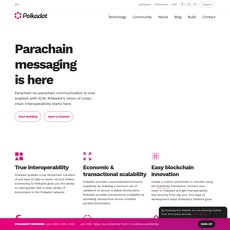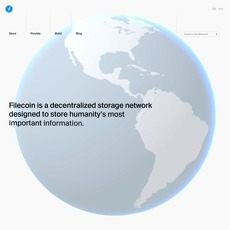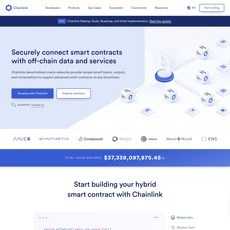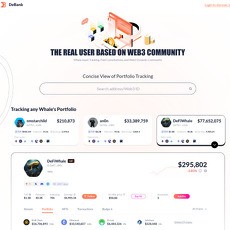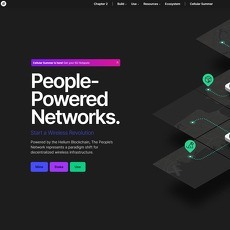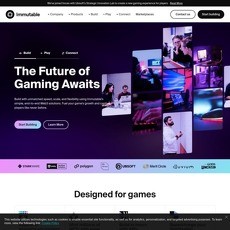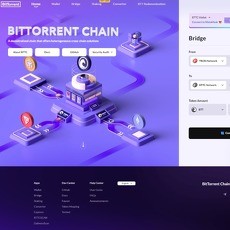The Graph Review
The Graph
thegraph.com
The Graph Review Guide: Everything You Need to Know (+FAQ)
How do apps like Uniswap load blockchain data instantly, letting you play with DeFi, NFTs, and cool dashboards in real-time? If you’ve poked around in crypto long enough, you’ve probably spotted The Graph—or at least noticed GRT tokens popping up on exchanges. But what’s behind all the hype, and should it matter to you if you’re not a hardcore dev?
Here’s what most people miss: The Graph isn’t just “another coin.” It’s like the search engine for blockchain data, making life way easier for both developers and regular users. In a world where *everything* seems complicated and full of buzzwords, let’s cut through the noise.
Where Most People Get Stuck with Web3 Data
Ever tried Googling “blockchain data queries” and ended up lost in a sea of tech-speak and endless threads where everyone assumes you’re running your own Ethereum node? Yeah, me too.
The Struggle for Clear Answers
I see a lot of sites tossing around terms like “data indexing,” “decentralized query protocol,” and “subgraphs”—often without explaining why any of it should matter. So here are the real questions most of us are looking for:
- What is The Graph, really? Why is it showing up everywhere in crypto?
- Is it actually useful, or just a fancy rebrand of something we already have?
- Is my data safe with it? Can I trust something I don’t even fully understand?
If you’ve ever found yourself searching for an answer while feeling like an outsider, trust me—you’re not the only one.
What You’ll Get in This Guide
I’ve put The Graph to the test in real-world scenarios—built apps with it, explored its ecosystem, and seen where it shines (and where it still needs work!). Here’s what to expect as you keep reading:
- Straightforward explanations. No jargon, just real-world breakdowns.
- Side-by-side comparisons. Can The Graph actually beat what came before?
- Use-case spotlights. See how top projects leverage The Graph for speed, reliability, and transparency.
- FAQ goldmine. Quick answers for folks who want the TL;DR before jumping in.
If you’re after a no-nonsense, field-tested look that actually helps you make a smarter crypto move (or impress your friends with some cool Web3 wisdom), you’re in the right place.
But what *is* The Graph, and why do so many developers swear by it? Stick with me—the next part is where things start getting even more interesting!
What Exactly Is The Graph? (And Why Is It a Big Deal?)
The Graph in a Nutshell
Let’s cut through the buzzwords—The Graph is pretty much the “Google” for blockchain data. It’s an open-source protocol that helps developers—think of anyone building dApps, DeFi tools, or NFT platforms—access, sort, and use blockchain data instantly. No need to set up gigantic servers or write scripts that break every time Ethereum gets busy. The Graph is the middleman who fetches information for Web3 apps, neat and quick, so users always get the latest data right at their fingertips.
Think of your favorite dApp, like Uniswap or Aave. Every time you check your stats or swap coins, you’re tapping into tons of data streaming from the blockchain. The Graph makes sure those apps can ask for—and get—the right info in an instant.
“I see The Graph as one of the most crucial pillars of the decentralized web—without it, so much of what we take for granted in Web3 wouldn’t be possible.”
– Dune Analytics co-founder Fredrik Haga
Problem The Graph Solves
If you ever tried pulling raw blockchain data yourself, you know how frustrating it can be. Blockchains aren’t built for quick searches. Every bit of info is scattered across millions of blocks. Before The Graph, people built heavy, custom backends to fetch and update blockchain data—a total time sink and totally not scalable.
- Developers wasted weeks creating scripts just to answer “Who owns this NFT?” or “What’s the total value locked in my favorite yield farm?”
- dApps crashed or lagged when traffic spiked because their data sources buckled under pressure.
- End-users paid the price with buggy apps, slow refreshes, and missing info.
The Graph stepped in and flipped the script. Suddenly, Web3 projects didn’t need their own data indexers. They could grab what they needed, when they needed it, thanks to something called “subgraphs.” But—I’ll break down subgraphs (with zero jargon!) in the next bit, so keep that curiosity alive.
What Makes The Graph Different from Similar Projects?
You might wonder—isn’t this just another fancy API? Here’s where The Graph has a unique spin:
- Fully Decentralized: Unlike traditional APIs run by Google, Amazon, or some random company, The Graph lets anyone join and help index data. No single gatekeeper, no “oops, we’re down for maintenance” moments.
- Designed for Web3: Solutions like Infura or Alchemy give you data, sure, but The Graph organizes it in a way that fits decentralized apps—think search engines that never go offline and don’t sell your info.
- Community-Powered: The more people using and supporting The Graph, the stronger it gets. Imagine Wikipedia, but for blockchain data, and contributors earn rewards.
Other projects tried to index blockchain info with brute force, but The Graph brought in a clever system where anyone can create or use a subgraph—public blueprints that describe exactly what data to pull, so everything stays lightning-fast and ultra-reliable.
Here’s the wildest part: over 70% of leading DeFi dApps (like Synthetix, Decentraland, and of course, Uniswap) rely on The Graph every day. It’s not a “maybe one day” tool—it’s already mission-critical.
But all this “subgraph” talk probably piqued your interest—how does it work behind the scenes, and how can you use it without needing a PhD in computer science? That’s exactly what I’ll break down in the next part, so if you want to see how data goes from blockchain chaos to your screen, keep reading!
How Does The Graph Work? (No Tech Degree Needed)
Understanding “Subgraphs”
Let’s keep this simple—imagine trying to find a specific photo in a massive, messy album. If every blockchain is like a stuffed filing cabinet, The Graph’s “subgraphs” are like smart, labeled folders that let you pinpoint exactly what you want… instantly.
A subgraph is a custom, open-source blueprint that tells The Graph’s protocol what data to look for (like NFT sales, DeFi trades, or game scores) and how to organize it. Rather than searching the entire blockchain every time, you just query the subgraph—making searches lightning-fast, reliable, and repeatable.
If you’ve checked out a DEX like Uniswap and seen live swaps, price charts, or trade histories, odds are you’re seeing The Graph in action, pulling all that info via subgraphs under the hood. It’s like having Google for blockchain data, tailored exactly to what you need.
Who Uses The Graph?
It’s not just for hardcore developers. Some of the biggest, most innovative Web3 projects—and even regular crypto users—rely on The Graph every single day. Here’s who’s using it:
- DeFi giants like Uniswap, Aave, and Balancer run on subgraphs for live stats and analytics.
- NFT marketplaces including Decentraland and Foundation instantly update assets and ownership thanks to The Graph.
- DAO dashboards, blockchain explorers, even cross-chain bridges trust The Graph to keep users up-to-date.
According to a recent study by The Graph Foundation, over a billion queries run through its decentralized protocol each month, supporting everything from dApps to analytics tools. No exaggeration—The Graph is powering much of what makes modern crypto user-friendly.
As one developer put it:
“Without The Graph, we’d spend days managing our own complex infrastructure and still get slower results.”
And if you’ve ever checked your DeFi earnings or NFT activity in real-time, you’ve probably benefited from it too—even if you never noticed!
How Queries Happen: Step By Step
Alright, let’s break it down—no technical jargon required. Here’s how your data gets from the chaos of the blockchain to user-friendly dashboards:
- Step 1: Someone builds a subgraph describing exactly what data is needed (like trades, wallet balances, or NFT ownership).
- Step 2: Indexers (special network nodes) scan the blockchain, organize info using the subgraph’s template, and store it on standby.
- Step 3: When you use an app—say, checking your latest NFT win—the app simply asks The Graph for your data, instead of digging through the entire blockchain.
- Step 4: The Graph instantly delivers clean, organized answers in seconds.
This process is why so many dApps can move fast, with up-to-date stats and smooth interfaces. You never see the magic in the background—but it’s what turns raw, hard-to-access blockchain info into something anyone can use.
Ever wondered how would you actually search or create a subgraph yourself—or whether you can even get involved if you’re not a tech wizard? That’s where things get truly eye-opening. Stick around, because up next, I’m sharing easy ways for both beginners and devs to experience The Graph firsthand… and yes, there are ways to earn too. Curious? Wait until you see what’s possible.
Getting Hands-On: How to Use The Graph
For Beginners: Just Browsing or Investing
Curious about The Graph but not sure where to start? Good news—getting a feel for what it can do doesn't mean you have to be a coder.
If you're simply exploring or considering investing in GRT, you can check out live subgraphs powering popular applications right now. The Graph’s Explorer is a public dashboard showing all active subgraphs. Think of it as a menu of different Web3 projects (like Uniswap or Decentraland) where you can see real-time blockchain data—no technical skills needed.
If you want to research GRT before making a move, the Explorer and community hubs offer token stats, staking details, and lots of FAQs. You’ll also come across guides on how to buy, store, or even earn a bit of GRT. Basically, you don’t have to be a developer to appreciate how The Graph makes blockchain data visible and usable.
“The best way to get started is just to start.”
Click around, study a few subgraph examples, and see for yourself where the value lies.
For Developers: Building with The Graph
For those who want to get their hands dirty and actually build Web3 applications, The Graph has become a favorite toolkit. If you’re wondering where to begin, head over to the official Graph Documentation—it’s packed with clear instructions, examples, and a community Discord that’s buzzing with helpful devs.
Creating your own subgraph lets you pull customizable data from blockchains like Ethereum, Arbitrum, or Polygon. There are even starter kits for common use cases (like NFT collections or DeFi protocols)—no need to start from scratch. Some devs have built full analytics dashboards and NFT marketplaces with just a weekend project. As the community grows, tools like The Graph Node, Subgraph Studio, and pre-built templates are making things smoother than ever.
Many real teams, from indie projects to top DeFi brands, have found The Graph’s subgraphs boost app performance and keep engineering costs down. The end result? Faster launch times, fewer headaches, and live blockchain data that’s always at your fingertips.
Tokens, Staking & Rewards
Want to get involved in the network beyond using or building with it? The Graph’s ecosystem offers some interesting ways to participate using the GRT token.
- Staking: If you’re holding GRT, you can stake it with trusted Indexers to help process queries for subgraphs. In return, you get a share of rewards (currently distributed based on your stake).
- Curating: Curators signal which subgraphs are valuable and should be prioritized. By staking GRT on promising subgraphs, you earn a cut of the query fees if they’re used often.
- Delegating: Not ready to run infrastructure? No problem—delegate your GRT to an Indexer and collect rewards, sort of like supporting a validator in other networks.
According to a recent survey shared by The Graph, more than 10,000 users are already staking GRT, with successful payouts and a growing number of subgraphs curated by the community. People love knowing they can earn passive rewards while actively contributing to the backbone of Web3 data.
It’s not just speculation—the more the network grows, the bigger the role for everyone who’s staking, curating, or just using the data.
Now, with all these hands-on opportunities—whether you’re a curious user, a builder, or an investor—one thing naturally comes to mind: is GRT actually a good investment, or just another hyped token? I’ve checked the facts, the risks, and the track record so you don’t have to. Ready to see the real story behind The Graph’s token and whether you should trust the hype? Let’s get into the numbers next...
Is The Graph a Good Investment or Just Hype?
Tokenomics: What’s the Deal with GRT?
If you’re eyeing The Graph from an investment angle, the first thing you’ll want to understand is GRT—the native token making it all tick. GRT isn’t just another random coin floating around; it’s at the core of the network’s incentives and security. Here’s how it plays out:
- Medium of Exchange: Every time someone queries data, GRT changes hands between consumers and service providers (indexers, curators, delegators).
- Staking for Security: Indexers have to stake GRT, keeping them honest and the network reliable. Mess up, and you risk losing your stash.
- Curating Quality Data: Curators put their GRT on the line to signal which subgraphs are valuable, shaping what gets indexed and what doesn’t.
The supply is set at 10 billion GRT at launch, with inflation to reward participants (currently ~3% annually). That might sound like a big number, but most is locked up in staking, making true circulating supply lower than you might think.
"A token is only as strong as its use case. GRT is literally the oil fueling the engine of Web 3.0 data."
Price History & Market Performance
Let’s be real: The Graph came out swinging in late 2020, and GRT was instantly all over crypto Twitter and top exchanges. The price popped from cents to an all-time high near $2.88 during the 2021 bull run. Since then, it’s seen the typical wild swings you expect from cutting-edge blockchain tech.
Here are a few highlights (as of early 2024):
- All-Time High: $2.88 (Feb 2021)
- All-Time Low: $0.052 (Nov 2022)
- Recent Range: Mostly trading between $0.10 and $0.30
- Market Cap: Frequently hovering in the top 50-100 cryptos
If you’d checked CoinGecko or CoinMarketCap during wild Web3 news weeks, you’ve seen GRT light up with volume spikes—often as major apps start using the protocol, or the team announces new features. This isn’t your average hype coin. But, yes, it’s just as volatile as any legit project in the crypto space.
Pros, Cons & Risks for Investors
I’m not here to sugarcoat it: investing in The Graph has its bright spots and speed bumps. Let’s get straight to the point:
- Strong Utility: Real projects and massive DeFi/NFT apps (think Uniswap, Aave) actually use it. Usage isn’t hypothetical, it’s live on-chain.
- Long-Term Vision: If you believe in the Web 3.0 stack, The Graph is in a rare league—sort of the “Google of blockchains.”
- Community Growth: The developer and staker momentum keeps snowballing, which is the lifeblood for any network’s staying power.
- Volatility: You can’t ignore this—it’s a young project. Big upside swings, but brutal corrections too.
- Protocol Risks: If a better indexing protocol comes along, or if GRT incentives don’t line up long term, things could shift fast.
- Regulation Watch: Like all utility tokens, there’s always some background noise about what’s legal in different countries.
If you’re searching for “100x overnight” action, you might get lucky—but that’s not what real Web3 infrastructure bets are usually about. The play for GRT is betting that reliable, permissionless data is going to be the backbone of the next-gen internet. But will the network—and its token—remain the top dog as the landscape heats up with competition?
I’m not here to call wins or losses. Instead, let’s see who stands behind the project and how trust is built into the network’s very bones—because tech is only as good as the team and transparency behind it. Curious? Let’s keep going, because the next part uncovers the real people, security, and legitimacy behind The Graph that could make or break your confidence.
Is The Graph Safe and Trustworthy?
When you’re poking around the crypto space, trust is everything. Let’s be real—there’s enough rug pulls and vaporware to last a lifetime. So, when you hear about something as invisible yet fundamental as The Graph, it makes total sense to wonder: can I actually trust this project?
Team Behind The Graph
The Graph isn’t some anonymous whitepaper with a Telegram group and hope for the best. It’s led by a team that’s refreshingly public: Yaniv Tal, Jannis Pohlmann, and Brandon Ramirez aren’t just the faces—they’re the brains, architects, and visionaries. Before The Graph, they worked on projects like functional search engines and APIs, which sounds boring until you realize that without this stuff, Web3 would crawl.
What really gives The Graph street cred, though, is the backing: they’ve pulled funding from heavyweights like Coinbase Ventures, Digital Currency Group, and Multicoin Capital. Even Ethereum’s own Vitalik Buterin has engaged publicly on the project’s future. And it’s not just investors and founders—Messari’s 2023 report spots The Graph as a “critical Web3 building block” that’s already powering thousands of crypto projects. You’re not trusting randoms with your data here.
Decentralization, Governance & Security
Here’s the question that always comes up: how do you know some central team won’t just flip a switch and take everything offline? The answer is decentralization. The Graph runs on a network of independent node operators (called Indexers) spread across the globe. No single actor can tamper with the data.
- Open Governance: Decisions are made by the community. GRT holders vote on proposals using on-chain governance, which means you don’t need to hope the team “does the right thing.” The rules are hard-coded—transparent, public, and auditable.
- Real Security: Security bugs are rare, but when they pop up, there’s a serious response. Check the bug bounty program on Immunefi—The Graph pays out up to $2.5 million for valid vulnerabilities! There haven’t been any headline-grabbing breaches, and the network survived the 2022 industry turbulence stronger than ever.
- Slashing & Rewards: Indexers and Curators stake GRT as collateral—if they mess up or cheat, they lose out. This “skin in the game” gives everyone an incentive to play fair.
“A blockchain is only as strong as its incentives and the people holding it together.”
That quote sums it up. The Graph’s whole security model is about aligning incentives—rewarding good actors, punishing bad ones, and letting anyone verify what’s happening.
Community & Support
The Graph isn’t just code and tokens—it’s arguably the most energetic Web 3.0 community outside of Ethereum itself. On Discord, Twitter, and their forums, you’ll find not just devs, but tons of users, builders, and crypto-curious folks helping each other out, swapping tips, and organizing grant projects. That grassroots vibe matters. In the 2023 EthGlobal Hackathon, The Graph was the #1 most integrated indexing solution, and their Discord community crossed 35,000 active users.
- Official docs: Clear, updated, and loaded with tutorials straight from the team.
- Discord: The quickest way to get help or meet fellow fans.
- Forum & Grants: Got a unique idea? The Graph grants program has funded everything from explorer tools to educational podcasts.
End of the day, no project is perfect, but The Graph consistently shows up with transparency, real accountability, and a genuine passion from its people. So, does all this actually work in the real world? Who’s out there betting their projects’ success on The Graph’s trustworthiness?
Stick around—you’ll want to see which heavyweight projects are building the next phase of Web3 with The Graph powering their data. The proof is in the pudding, and what comes next might just surprise you.
Real-World Examples: Who’s Actually Using The Graph?
Big Names and Projects
If you’re wondering whether The Graph is just hype or actually useful, check this out—some of the biggest and most active projects in crypto use The Graph as a core part of their infrastructure. We’re talking about real stuff, not just theories and wishful thinking.
- Uniswap: Ever used Uniswap or checked token prices and volumes in real time? That fast performance relies on The Graph’s subgraphs to index and deliver live trading data from Ethereum. Without it, decentralized exchanges would feel slow and clunky.
- Decentraland: In this wild, virtual world where land, avatars, and experiences are bought and sold as NFTs, The Graph helps make in-world data easily searchable for all users. That's how you can instantly see who owns what parcel or browse assets.
- Audius, Synthetix, PoolTogether, Curve, Balancer: These aren’t just test projects—they’re the backbone of DeFi, NFT platforms, and even music streaming. They all use The Graph for blazing-fast, reliable blockchain data.
What’s cool is that you can actually browse public subgraphs for these platforms and see how many requests go through daily—sometimes millions. Check out The Graph’s Explorer if you want proof that this is happening 24/7.
Why Developers Pick The Graph
So, why do these projects trust The Graph instead of building their own solutions? It comes down to speed, cost, and access. Here’s what builders are saying:
“Without The Graph, we'd be building and maintaining our own indexing infrastructure—which means less time innovating and more time fighting fires.”
— Scott Lewis, Co-founder of DeFi Pulse
- Save time and money: Developers can skip building complex data solutions, saving months of development and big server costs.
- Collaboration made easy: Open subgraphs mean projects can share their data models, making the whole Web 3.0 ecosystem more connected.
- Focus on your product: Teams spend less energy on data headaches and more on building stuff users actually want.
Communities like The Graph Docs and their Discord are full of devs helping each other spin up subgraphs for everything from DeFi to NFT analytics.
Success Stories & Growth
If you like numbers, get this: Over 8000 subgraphs have been published and thousands of teams are using The Graph every day. According to The Graph’s own stats, query volume smashed past 1 billion per day in 2023. And adoption isn’t slowing down.
- DeFi Pulse scaled up from tracking a few protocols to hundreds without re-engineering their backend every month.
- NFT analytics services now launch in weeks, not months, thanks to The Graph doing the heavy lifting for real-time data.
- Growth studies (Messari, 2023) point out projects using The Graph scale faster and attract more developer talent, thanks to reusable subgraphs.
It’s one thing to be a promising tool—it’s another thing to become the power grid of Web 3.0 data. The Graph is quietly running under the hood of the apps and games you might already love.
But here’s the next big question: Is The Graph really just one gear in the giant Web 3.0 machine, or could it be the secret glue that's making all these pieces work together? In the next section, I’m pulling back the curtain on how The Graph fits into the larger Web 3.0 picture—and which other projects you should keep an eye on. Stick with me, because if you care about the future of the internet, you’ll want to see what comes next.
How The Graph Fits into the Big Picture of Web 3.0
A Link in the Web 3.0 Chain
Web 3.0 is supposed to be about freedom, ownership, and taking back the internet from the big guys. But let’s be real—none of that works if applications can’t reliably find and organize blockchain data. This is exactly where The Graph swoops in. Think of it as the Google of blockchains, enabling everything from DeFi protocols to NFT marketplaces to actually run smoothly by indexing and serving up data in real time.
With The Graph, apps like Uniswap or Decentraland don’t have to reinvent the wheel every time they need data—they simply tap into flexible, decentralized channels known as “subgraphs.” In fact, over 1,000 projects lean on The Graph’s infrastructure to stay nimble, secure, and censorship-resistant. Without reliable access to blockchain data, features like instant swaps, NFT galleries, and on-chain analytics would fall apart. It’s not just an accessory; it’s a backbone.
Other Top Projects to Watch
If you’re as geeked about the future of the internet as I am, it pays to keep tabs on more than just The Graph. Several other heavyweight projects are helping stitch together the Web 3.0 ecosystem—each tackling a piece of the puzzle:
- Polkadot (DOT): This project acts like a digital translator, letting different blockchains talk to each other. Imagine sending assets or info between Ethereum and some obscure new chain, all thanks to Polkadot’s magic. Interconnected ecosystems are the future, and interoperability pioneers like Polkadot are making that happen.
- Chainlink (LINK): Blockchain apps are brilliant, but they’re often clueless about real-world events. Chainlink solves that with reliable data feeds—think insurance payouts that depend on tomorrow's weather or DeFi loans that price in live market rates.
- Filecoin (FIL): Forget storing your files in one place—what if they were safely scattered across thousands of independent computers? Filecoin pays users for sharing their storage, creating a more robust, censorship-resistant cloud.
To see which projects are gaining traction, what problems they’re tackling, and some honest reviews, check out Exploring the Top Web 3.0 Crypto Projects: A Comprehensive Web3 Review. It’s packed with real-world examples and advice on navigating this wild new internet.
Is Web 3.0 Here Yet?
Let’s face it—Web 3.0 is ambitious, and we’re not quite living in the decentralized utopia (yet). Adoption is growing: according to Blockchain.com Research, we’ve hit over 10,000 active crypto projects in 2023, with DeFi users and NFT collectors leading the charge. But the roadblocks are real:
- User Experience: Many dApps are trickier than they should be. Wallet management and gas fees can scare off newcomers.
- Scalability: Network congestion still slows things down, but advances in layer-2 tech are promising some big leaps.
- Regulations: Uncertainty around crypto laws keeps both developers and investors on their toes.
And yet, community energy is electric. Teams everywhere are working overtime to make decentralized apps just as easy—and much more empowering—than their Web 2.0 cousins. Trends like the surge in active dApp users (as reported by DappRadar) and huge growth in DeFi show that average people are starting to get a taste for Web 3.0’s possibilities.
Have you wondered what it’ll take for Web 3.0 to go mainstream, or what you can realistically expect in the next few years? The answers might surprise you, especially if you’re considering getting in early. Want to know what you should watch out for, or how to make Web 3.0 work for you? You’re one scroll away—let’s hit the FAQs and zero in on the real questions everyone’s asking. Ready?
The Graph FAQs & My Final Take
Quick FAQ: What People Ask Most
Let’s cut right to it—here are the top questions (and straight answers) I see about The Graph, whether you’re thinking about putting your money in, using it as a dev, or you’re just curious:
- What is The Graph actually used for?
The Graph is the backbone for querying and organizing open blockchain data. Whenever you use apps like Uniswap, Decentraland, or even NFT explorers, there’s a good chance The Graph is working in the background. It does the heavy lifting so that dApps can grab the data they need—instantly, securely, and without crazy costs or slowdowns. - Is The Graph a good investment?
No crystal ball here, but GRT (The Graph’s native token) is what powers the ecosystem. You stake it to earn rewards, pay for queries, and keep the network honest. GRT has seen serious ups (and downs) since launch, like most crypto, so the usual warnings apply: it’s volatile, and the future depends on where Web3 adoption goes. CoinGecko’s data shows over 80% of GRT’s supply is staked or locked, which signals strong community belief, but always do your own research and don’t invest more than you’re willing to lose. - Is The Graph safe?
The architecture is decentralized, audited, and open source. This means no single point of failure and the code’s out in the wild for anyone to review. Of course, nothing is 100% risk-free in crypto, but so far, The Graph’s had no major hacks or scandals. Its governance is also community-driven, so changes require broad agreement. - Can I participate if I’m not a coder?
Absolutely. You can explore public subgraphs (think: curated data feeds for things like NFT trends or DeFi stats), stake GRT, or just keep an eye on the action for investment purposes. You don’t need to build dApps to benefit—plenty of ways in for regular users.
Should You Use or Invest in The Graph?
Here’s who I think gets the most out of The Graph:
- Developers: If you’re building any blockchain app, data is your biggest roadblock. The Graph takes care of that, so you can actually focus on features—not backend headaches. The dev docs are detailed, the community’s pretty active, and you’ll find help fast. If you peek at major Ethereum dApps like Uniswap, you’ll see they’re using The Graph because nothing else is as fast or reliable at this level.
- Investors: If you truly believe in a future where Web3 takes over the web, The Graph is one of those “infrastructure” picks—like buying internet routers before everyone was online. Return potential is tied directly to Web3’s rise (or stall), so weigh your risk appetite. Institutional players are watching these types of picks closely, as shown by spikes in GRT volumes during major NFT booms.
- Regular users & crypto fans: Even if you’re not building anything, browsing subgraphs or staking tokens can be rewarding. You can track NFT stats, DeFi pools, or market trends straight from the source—no need for trust in some random website’s numbers.
Wrapping It Up: My Honest Opinion
Here’s where I stand after all that testing, peeking under the hood, and comparing The Graph to dozens of other tools:
- The Graph is one of those “silent heroes” of crypto. If open, decentralized apps are going to stick around, something like The Graph is absolutely needed for any project that cares about real-time data—without it, we’d be crawling through blockchain data with a flashlight and a map from 1998.
- I like that you don’t have to be a genius coder or mega-investor to get involved. The learning curve is gentle if you just want to explore, but the tech is deep and powerful for devs who want to go all in.
- Of course there are risks: reliance on Ethereum right now (though other chains are coming), GRT’s price swings are not for the faint of heart, and the Web3 space is still the Wild West. But compare it to most “hype” projects, and The Graph actually works—and real projects use it every day.
Want my advice? If you care about where crypto and Web3 are going, keep an eye on The Graph. Test a subgraph. Stake a little GRT if you’re adventurous. See what’s being built, and decide if this fits your vision of the future internet.
Before making any big investment, always research and never chase hype alone. And if you’re looking for deep, bias-free breakdowns of top crypto projects, check out my reviews and news updates at Cryptolinks.com. There’s always something new happening behind the scenes!


